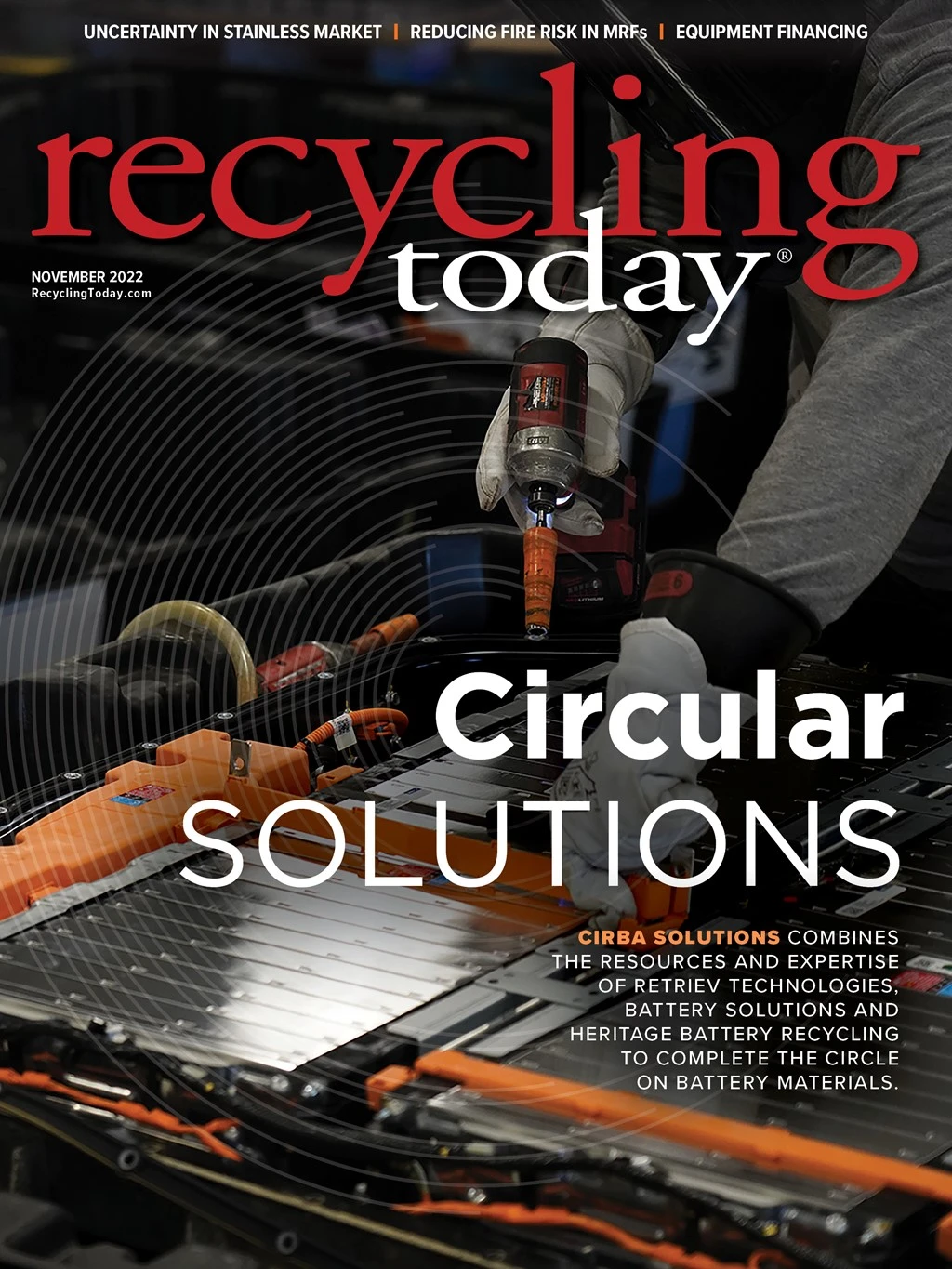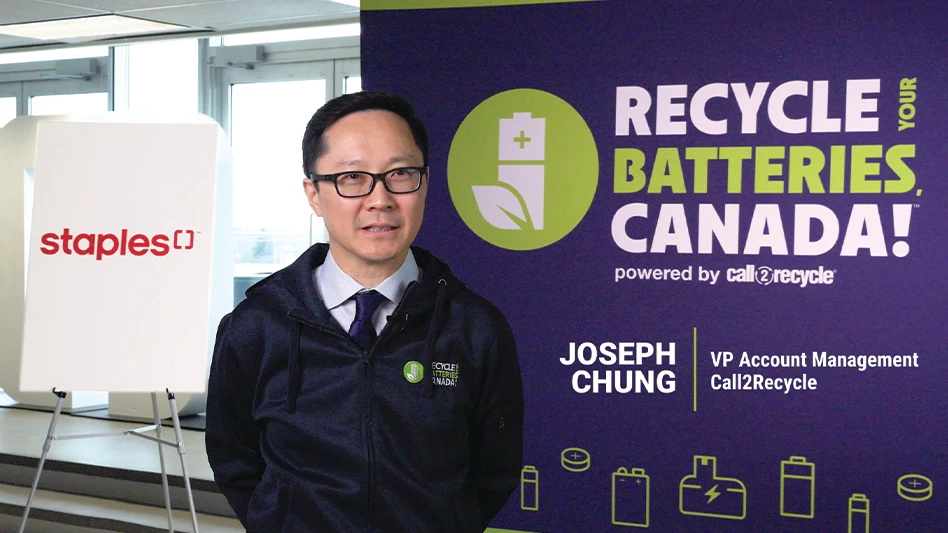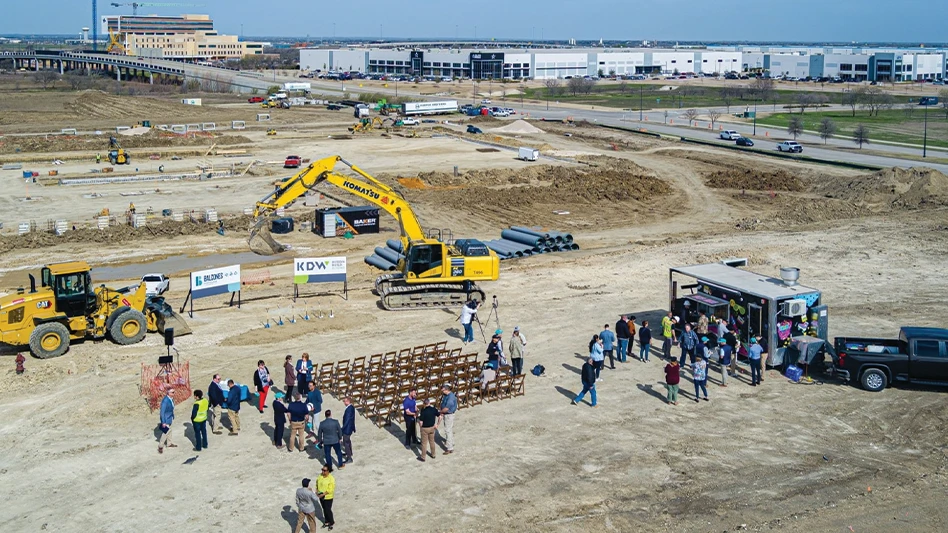
The rise of lithium-ion batteries in residential and commercial recycling streams has led to an upsurge in fires at material recovery facilities (MRFs).
Fires in waste and recycling facilities have risen from 347 known incidents in 2016 to 1,395 in 2021, according to data compiled by Ryan Fogelman, vice president of strategic partnerships for West Bloomfield, Michigan-based Fire Rover, a company that uses heat-detection, remote-controlled suppression and monitoring services to protect businesses from fire.
Lithium-ion batteries present a greater fire risk than alkaline batteries, according to Evan Williams, a design product manager for Cambridge Cos. Inc., a Scottsdale, Arizona-based design-build firm that serves the waste and recycling sector.
“If you just have a single battery and kind of crack it open and it starts combusting, it sort of burns itself out,” he says. “But when it’s at the bottom of a pile of material, and it gets that [pile] going, that could be a real problem.”
The activity within MRFs and the materials flowing through them make the facilities inherently high risk for fires, Williams adds.
“They’re essentially full of combustible materials, some more flammable than others,” he says of lithium-ion batteries, and the activities that occur in a MRF potentially could damage these batteries.
If a crushed or punctured battery is at the bottom of a pile, it might not start a fire immediately. “It can be delayed for an hour, two hours or four hours,” Williams says, presenting challenges.
On the tipping floor
Because of the potential for lithium-ion batteries to spark fires, Williams says he considers designing a MRF in sections.
“The best way to approach it … is to sort of segment the risks and areas of the building and try wherever possible to use best-practice approaches to eliminate the risks or make them more manageable,” he says.
The greatest danger often begins on the tipping floor, Williams adds. “If you dump a load of material on a concrete floor and move it around with the wheel loader or run it over with a tire, you’ve created the perfect [situation] to heighten those risks,” he says.
When material enters a MRF, Williams says it’s a good idea to have a designated area for hot loads that can present a fire risk.
“As a load comes in and they start dumping it … if they notice smoke coming out, [they should have] a clearly defined space outside the building that’s not close to anything where they can dump that’s adjacent to a hydrant so they can put out a fire if [needed],” he says.
Such areas should be located close to the tipping floor in case employees need to move a pile that begins smoldering after they’ve moved it into the MRF, Williams adds.
Because the buckets on wheel loaders can damage batteries, some MRF operators try to take the bite out of the blades that push materials around on the floors.
“There are companies that make … buckets that basically have a bolt-on rubber edge, and that reduces the amount of sparking on the floor,” Williams says. “That’s definitely something that we’re encouraging clients to look into.”
But, according to Susan Eppes, corporate safety manager for The Woodlands, Texas-based Waste Connections, once the day ends, the danger is not over.
“We wait an hour before people leave the facility—a minimum of an hour,” she says. “The reason for that is if we ran over a battery or if we ran over something else flammable … we feel an hour is a sufficient time for that [potential fire] to occur before we leave the facility.”
To help reduce the risk of a fire occurring after hours, Williams says MRF operators should consider processing all material received on a given day so the tipping floor doesn’t have piles sitting overnight.
Eppes says MRF operators also need to understand where their own risks are and adjust safety procedures accordingly.
Batteries on the line
Batteries that get into processing machinery are a greater fire risk than those on the tipping floor, Williams says.
“It could start combusting in your system as the conveyors are carrying it through the building, and you’re basically sort of distributing the fire throughout the facility,” he says.
However, facilities can take measures to minimize that risk.
First, he says employees who are on the presort lines need to be aware of the possibility of small batteries getting to that stage of the system.
“The problem is it’s not necessarily as simple as just flipping the system in reverse and sending the material back once it’s on the crossing conveyors,” Williams says, adding that workers should have access to a kill switch or an emergency stop.
Using a trommel screen before or immediately after the manual presort also can help remove lithium-ion batteries.
“Most MRFs will have an infeed, and they’ll go through a presort subsystem and run the material through a trommel,” he says. “If you do have a trommel out front, typically those [batteries are] dropping to the bottom, so they would be removed almost immediately. Because they’re round and heavy, they fall easily, so they’re going to drop the bottom of the trommel.”
If batteries do make it through the processing system, they also can cause problems in finished bales, Eppes says.
“A lot of people are putting thermal camera systems in their bale storage areas so they can at least see [signs of a fire] in the first five minutes or so,” Eppes says.
Containing the fire
If a fire does start, a variety of equipment and design choices can prevent its spread.
A Fire Rover system that includes thermal cameras and a high-pressure extinguishing system can help detect and control fires that aren’t noticed or that spark overnight, Williams says.
Fire Rover uses thermal detection to alert its monitoring staff when temperatures rise too high in a given area. Once that thermal rise has been detected, the staff then can confirm whether danger is present or if machinery near the thermal camera could be causing the spike.
“They would be able to then zoom in and check the temperature and how it’s evolving, and if it does appear that there is a smolder starting in there, essentially, they have a fire foam system with an articulated cannon they could spray at the hotspot,” Williams says.
Another option for extinguishing fires is a deluge system. These systems can be actuated manually or by a spike in temperature. Deluge systems also can be customized to douse fires based on the flammability of various materials.
Many facility operators have a misconception that sprinkler systems are designed to extinguish fires. Rather, Williams says, they’re designed to prevent fatalities. Making use of deluge systems is a good idea for protecting property.
When designing a MRF, he says minimizing damage from fires should be a top consideration. The structural elements of the tipping area, for example, should not span the entire facility. If a fire occurs in the tipping area and heats up a girder spanning the facility, that girder could collapse and damage the entire MRF. If separate structural parts are used, a girder that heats up and collapses in one area won’t destroy the entire facility.
“Best practice would be a fire separation wall,” Williams says. “We have done that in some facilities where we literally had a floor-to-ceiling, 40-foot-tall concrete wall between the tipping and processing areas, and the structure on each side was independent.”
When designing a MRF, Williams says it’s important to involve fire suppression contractors early on.
“If they’re not given all the information about how you want to operate the facility, they won’t know,” he says. “They’re going to proceed based on what they’re told or what they’re given.”
Get curated news on YOUR industry.
Enter your email to receive our newsletters.

Explore the November 2022 Issue
Check out more from this issue and find your next story to read.
Latest from Recycling Today
- Recycled steel price crosses $500 per ton threshold
- Smithers report looks at PCR plastic’s near-term prospects
- Plastics association quantifies US-EU trade dispute impacts
- Nucor expects slimmer profits in early 2025
- CP Group announces new senior vice president
- APR publishes Design Guide in French
- AmSty recorded first sales of PolyRenew Styrene in 2024
- PRE says EU’s plastic recycling industry at a breaking point






